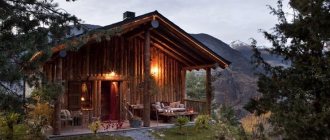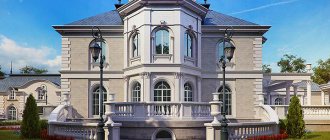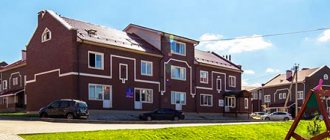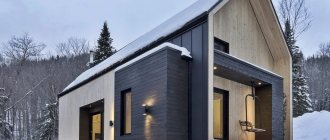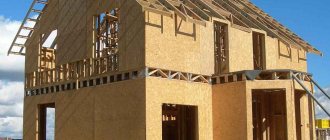A private cottage, stylized as a medieval castle, is a very unusual, original and extraordinary, but at the same time spectacular solution.
There is an opinion that the construction of such a building requires a lot of time and money. However, it is not. Professional construction companies today can offer a number of ready-made and inexpensive design projects or develop individual plans based on all the wishes of customers.
In this article we will talk about the features of castle-style cottages, interesting projects and design solutions.
Classic features of the medieval style
This trend in interior design takes its origins from medieval England, with its majestic castles and crusades. High arches of castle facades with observation towers that seem to carry upward the gaze of those looking at them. Stained glass, creating a special vision of the interior space, in combination with large window openings, is truly mesmerizing.
Even modern castle-style buildings look much more attractive than monotonous cottages and frame houses
Medieval style in the interior - bright, luxurious and exclusive
The interiors of those years are distinguished by a rich and rich color palette.
In addition to the external architectural features of the castles, these knightly chambers are distinguished from ordinary homes by the interior decoration of the rooms. The special features of a medieval-style room include the following:
- Rough interior surfaces. This is evident in all elements, from floor finishing to interior furniture.
- Massive design elements. Ceiling beams as interfloor ceilings, stone columns, architectural elements of arches, fireplaces, chests - all this emphasizes the medieval interior.
- Particular emphasis is placed on lighting in the castle. Copper three-prong candlesticks or even torch lights will add mystery and mystery to the atmosphere of the interior of the room.
- Stained glass. Images and silhouettes paved from multi-colored glass are a wonderful gift from the past in the Romanesque style.
An invariable attribute of the living room is a real wood-burning fireplace.
Statues of knights, dragons or horses are suitable as decoration.
The general atmosphere in the room should be such that you feel like you are behind the stone wall of an impregnable fortress
The best material for finishing doorways would be oak or oak-based panels
All these features can really be brought to life in an ordinary city apartment.
Inner space
It is equally important to pay attention to the interior decoration of the castle-style cottage. First, you should correctly and accurately plan the placement of electrical wiring.
Don't forget about fire safety. In principle, the pipes of heating and water supply systems are placed according to a standard layout. As for light sources, to give the rooms a medieval look, you can place a large number of lamps around the perimeter. For more ambience, you can install candles in the bedrooms and living rooms.
Experts who have been constructing buildings in medieval style for many years give some advice on arranging their interior space:
- to decorate walls, floors and ceilings, you can use marble, decorative stone or modern products that imitate similar building materials (this option will be much cheaper);
- You can also simply plaster the walls and ceilings, and subsequently paint them in any suitable color;
- antique furniture will fit perfectly into the overall interior of absolutely any room (however, you should not install it in a nursery);
- curtains should be made of natural fabric, and fur accessories, tapestries, stuffed animals will complement the interior ambiance.
In addition, it would be a good idea to decorate the interior with several paintings decorated with gilded frames.
Another accessory that will optimally fit into the interior of a castle house is massive, original bookcases for storing books. And the books themselves obviously won’t hurt!
Since the project of building your own castle is complex and requires special skills of designers and builders, it is recommended to regularly monitor the actions of the construction company’s craftsmen. Be careful when signing the contract, clearly write down all the details and do not be deceived!
Did you find this article helpful? Please share it on social networks: Don't forget to bookmark the Nedvio website. We talk about construction, renovation, and country real estate in an interesting, useful and understandable way.
How to build a medieval castle from scratch?
In the French province of Burgundy, a team of enthusiasts is building a medieval castle from scratch using only medieval building materials, tools and technologies. Construction began in 1997, the project is expected to last 25 years.
The idea of building a medieval castle came from archaeologist Nicolas Faucherre and architectural historian Christian Corvisier during an archaeological study of the medieval castle of Saint-Fargeau. The castle was built back in the 10th century, and then it was reconstructed and rebuilt several times. As a result, the "latest version" of the castle was built on foundations and materials from the 13th century. The owner of the Saint-Fargeau castle, Michel Guyot, decided not to restore his own castle, but to build a castle nearby, similar to Saint-Fargeau in the 13th century.
Guidelon Castle in 2005
Christophe.Finot / Wikimedia Commons
Castle in 2009
Odejea/Wikimedia Commons
Castle in 2015
Asmoth/Wikimedia Commons
The forest of Guidelon, 13 kilometers from the castle of Saint-Fargeau, was chosen for construction. Here were all the materials needed for construction: an abandoned quarry, a large forest and a pond nearby. The future castle was also named Gidelon, in honor of the forest surrounding the construction site. The castle project was created by the architect Jacques Moulin according to architectural canons developed during the reign of King Philip II (1163-1223). The king ordered the creation of a standard plan according to which fortified castles were built in France. The territory of the castle, built according to a standard plan, was a polygon, it was surrounded by high walls, and a dry moat was dug around the castle. The entrance to the castle was protected by cylindrical towers. Round towers with embrasures were built at the corners of the castle; one of them, the “lord's tower,” was taller and larger than the others.
Ratilly Castle was built according to the architectural “standard” of the 13th century.
Thierry de Villepin / Wikimedia Commons
A team of 70 people constantly works at the castle, 40 of whom are engaged in construction work. In addition, approximately 650 volunteers come to the castle each year to work in the quarry and as masons, carpenters and stone carvers. Project participants expect to complete construction in the early 2020s. In 2021, it is planned to break down the stone blocks and build a passage along the western wall of the castle. Carpenters will build a temporary wooden bridge on the eastern wall of the castle, which will be laid over the moat. Later, the bridge will be replaced with a permanent stone one, and wood will be transported to the castle via a wooden bridge to build the roof of the defensive towers. It is also planned to paint the walls of the chapel built a year earlier.
The work is carried out under the supervision and guidance of experts - archaeologists and historians from French universities. At the same time, the learning turns out to be two-way: on the one hand, experts advise and approve (or disapprove) of the decisions of the project participants, on the other hand, for archaeologists and architectural historians, Gidelon has become a storehouse of information about what technologies or tools were used at one time or another and about construction management in general.
At first, the project's leaders and instigators were the owner of Saint-Fargeau, Michel Guillot, and businesswoman Marilyn Martin, who wanted to create new jobs. A few years later, the castle grounds were opened to visitors and now 300,000 tourists come here every year.
Marfino Estate
Photo source: Instagram
Over the years, the estate belonged to the princes Golitsyn, counts Saltykov, nobles Orlov and Panin. Now you can live there too - the building houses the Marfinsky sanatorium of the Ministry of Defense. It was on the territory of the estate that the shooting of the scene “Satan’s Ball” from Yuri Kara’s film “The Master and Margarita” took place.
Since 2021, the department has opened free access to the garden and park ensemble of the estate and sanatorium for everyone. You can go there every day, from 09:00 to 17:00, but to get into the territory, you need to show your passport at the checkpoint. The estate is located in the village of Marfino, Mytishchi urban district.
Locks. Origin story
The beginning of the construction of palaces for high-ranking persons dates back to the 10th century AD. It was at this time that wars broke out in the world between various principalities and states. To protect cities, fortresses were equipped with moats, strong walls, and towers.
The latter were most often made round or polygonal. The larger the fortress, the more majestic its owner looked. Mostly very influential and rich people lived in medieval castles.
Subsequently, such structures were often rebuilt not to protect their possessions, but as residences for influential people. Today, castles built in the Gothic, classical or Renaissance styles are considered historical monuments.
Castles began to be created in Russia, starting with the construction of kremlins and protective structures. Then they were built as palaces for emperors and people close to them. The most famous domestic buildings are: Mikhailovsky, Vyborg, Peterhof architectural ensembles.
There are a number of very interesting facts about the castle mansions:
- As a rule, the toilet in them was dressing rooms, which were equipped with an ordinary hole;
- they were built on a hill to make it easier to spot and destroy enemies;
- natural wood was used to recreate the first buildings - this was necessary so that in the event of a lost battle for the territory they could be easily burned;
- staircases in such structures were always made spiral-shaped - they also performed a defensive function (it was harder for the enemy to get into the head tower).
About everyday life
To better understand the conditions in which people lived, it is worth considering the dirt of the cities of that era. City residents poured slop directly onto the streets. Populated areas were buried in mud. Thus, one historical anecdote features a knight who drowned in the center of the city in a puddle of mud while riding a horse.
The architecture was also unique. Cities were built with houses of several floors, which were crowded together to increase living space. Since there were “canopies” over the streets, they were very dark and narrow. Lighting here was provided by torches. Often the combination of these factors led to fires.
The rich part of the population built castles. The interior decoration of the medieval castle was also brutal and primitive.
These structures were built of stone and had many rooms. In the center there was a hall, a hearth. This area acted as a living and dining room. The decoration of a medieval castle will amaze any modern person with its meagerness.
Most often the floors were earthen. And only the richest people could afford to cover the floor with stones. Sometimes the interior of a medieval castle was complemented by a mosaic floor.
 Provide water and sewerage
Provide water and sewerage
Don't forget about the "conveniences".
You will appreciate them in the event of a siege. The most important aspect for the castle was efficient access to water. These could be wells that supplied water to certain buildings, for example, a kitchen or stable. Without a detailed knowledge of medieval well shafts, it is difficult to do them justice. For example, at Beeston Castle in Cheshire there is a well 100 m deep, the top 60 m of which is lined with cut stone.
There is some evidence of complex aqueducts that brought water to the apartments. The tower of Dover Castle has a system of lead pipes that delivers water to the rooms. It was fed from a well using a winch, and possibly from a rainwater collection system.
Effective disposal of human waste was another challenge for lock designers. Latrines were collected in one place in the buildings so that their shafts were emptied in one place. They were located in short corridors that trapped unpleasant odors, and were often equipped with wooden seats and removable covers.
Reflection room at Chipchase Castle
Today, it is widely believed that restrooms used to be called “wardrobes.” In fact, the vocabulary for toilets was extensive and colorful. They were called gongs or gangs (from the Anglo-Saxon word for "place to go"), nooks and jakes (the French version of "john").
Advice
: Ask a master mason to design comfortable and private latrines outside the bedroom, following the example of Henry II and Dover Castle.
Roughness of materials
When choosing interior elements, you should pay attention to the characteristics of the materials that are used here. So, materials must be reliable, rough
The inaccessibility of the walls is perfectly recreated by stone and bricks. Ideally, such a covering should be supplemented with wooden beams.
The central place of any medieval home is the fireplace. Sometimes in modern settings an artificial analogue is used. It makes sense to place a lot of wrought iron fireplace accessories near the hearth. This will make an important contribution to the creation of a medieval ambiance.
The massiveness of furniture in dark shades will also complement the atmosphere of these dark ages. A canopy must be hung over the sleeping area. This picture is complemented by a chest with forged elements.
The thing is that in the Middle Ages forged parts were often used in combination with wood, stone and other types of materials. Metal inserts can be present in any furniture. For example, the head of the bed may contain forged parts.
Of course, the symbol of the Middle Ages are knights. This means that in the room you need to create the feeling that one of them lives here. It makes sense to complement the interior with coats of arms and heraldic patterns. Shields, weapons, armor, hunting trophies - stuffed animals are suitable.
Design features of the medieval castle project
1. Project of a house in the medieval style “VASSAL CASTLE” with a total area of 1007 m22. The relative level of 0.000 is taken to be the level of the finished floor of the first floor, equal to the absolute level - which is determined after the medieval castle is planted according to the project on a specific site.3. The outer walls of the house in a medieval style are made using the B1ie Max technology. The thickness of the external walls is 360 mm. including drywall on the premises side. (29 + 70)4. Monolithic reinforced concrete floors on metal beams (concrete m 300 b = 100 mm), floor thickness 70 mm5. The external walls of the house in the medieval style are decorated with plaster parts, forged items and plastered for subsequent painting in agreement with the architect.6. The basement walls are made of monolithic concrete with insulation (see section KR). The base is lined with artificial stone.7. Internal partitions are plasterboard on a metal frame, 152mm thick.8. The windows are made of PVC, using double-glazed windows, the profile color is “golden oak”, with anti-mask nets on the tilt-and-turn windows.9. External doors are insulated metal with stained glass windows. (see specification for filling doorways). White insulated garage doors.
10. The distribution of utilities is carried out in the space of the false ceiling. 1st floor 3050 mm (clean 2nd floor 3050 mm base 3050 mm floor heights
11. According to the project, the main entrance staircase of the medieval castle is made of concrete and tiled.12. Warm electric floors are installed in the following rooms: stairs and landing, vestibule of the main entrance.13. The roof structures are wooden rafters. Roof covering (roofing) - bitumen tiles. "BP" color - Arsylse gizidie 14. All dimensions are given in mm, marks in m. 15. Color of soffit lining and gutters - white 16. Internal staircase is made of monolithic reinforced concrete with tile cladding. Real drawings of the house in in the form of a castle are made in accordance with current building standards and rules, including explosion and fire safety, and provide solutions that ensure safety while observing the established rules for operating a house in the form of a medieval castle.
General instructions for the electrical supply of a house in the form of a medieval castle
Working drawings for the project of a medieval house were developed on the basis of a design assignment. According to the degree of reliability of power supply, this object belongs to consumers of category III. The estimated power on the roof is 20 kW. The low-voltage line is provided from the existing support of the overhead line - 0.4 kV. The wire is adopted to be self-supporting with aluminum phase conductors conductors, with insulation made of light-stabilized cross-linked polyethylene, with a supporting conductor made of aluminum alloy type SIP-2A with a cross-section of 4x25mm2
The selected wires are checked for permissible voltage losses, the value of normalized voltage deviations at electrical receivers complies with the requirements of GOST 13109-87 (+5%)
Features of buildings in the castle style
Such original houses are recognizable at first sight
Even if you take only part of the concept or change something in the layout, your small castle will still attract attention. This is the main feature of such buildings
Most often, castle-style buildings are distinguished by their massiveness. Like real medieval castles, buildings stylized as them are always solid.
Such a house immediately gives the impression of a solid structure in which more than one generation of your family can live in peace. Otherwise, both the design and its external decoration depend on the preferences of the home owners.
Spis Castle, Spisske Podhradie, Slovakia
On the tops of dolomite rocks is located the largest castle in Slovakia, the inaccessibility of which is the subject of legends. Today its gates are open for guests who want to wander through the former chambers of the noble owners of the castle, shoot with medieval weapons or take part in a historical reconstruction.
Website: spisskyhrad.sk
Tower construction options
Structurally, it can be erected:
- round, created as a living room. Very often, spiral staircases leading to the upper floor or attic are installed in them. The walls of such a tower are topped with small window openings. A new trend in home construction is the construction of glass towers. This direction is just in its infancy, becoming increasingly in demand;
- square, which is created as a bedroom or office. In some projects, a square tower is used as a living room;
- rectangular, which can perform the same functions as a square tower.
They can be built at different heights and be smaller than the building or have the same height as it. The number can also be unlimited, but the most common are houses with two towers.
A small round tower, suitable only for an observation room
Square observation tower on the roof of a house
Rectangular tower with high windows
Bright red and white house with a small round residential turret
Bodiam, East Sussex, England
Surrounded by a moat and seemingly floating on water, Bodiam Castle is one of the most picturesque ancient fortresses in England. In addition to spiral staircases, crenellated bastions and picturesque landscapes, guests can expect costume performances, archery, a medieval quest and other entertainment.
Website: nationaltrust.org.uk
Architectural styles
The architecture of brick castles has several main directions. The first of them is classicism. These architectural ensembles are characterized by a special severity and smoothness of forms, symbolizing aesthetic value. The project of a brick country house, created in a classical style, lacks exquisite architectural details. The facade of the cottage resembles the appearance of a Greek temple. The painting of buildings is dominated by a light spectrum of colors.
The Gothic style is distinguished by the height of the walls ending in vaults, as well as floor-to-ceiling windows with unique stained glass windows. There is a sufficient amount of sunny color coming through the colored patterns. The main elements of Gothic architecture are ribs (pointed arches), flying buttresses (open semi-arches), pointed openwork towers. Castles in the Gothic spirit symbolize infinity, mysticism and mysteries that exist in the human soul.
Uncomplicated, simple architectural lines of the Renaissance. If a brick castle is created in this style, then the space in it has clear, convenient zoning. Objects that fill the home are rectangular in shape. An essential element of landscape design is a courtyard surrounded by a series of arches supported by columns or pillars. The house will suit owners who prefer the natural beauty of the surrounding area.
A distinctive feature of baroque country brick castle projects is their bombast and intricacy. The building has a blurred silhouette due to the use of rounded and smooth lines. All parts of the house are richly decorated. Non-functional original components are created to decorate the castle. The pomp and scale of the building is striking. In the cottages there is a combination of flashy colors, gilding, colonnades and other delights.
Stylistic decisions
There are several design variations in which cottages are now being rebuilt as luxury mansions on the market.
Gothic
One of the most popular is the Gothic one: despite the fact that such a building may look gloomy from the outside, its main decorations are stained glass windows, wide arches, and beautiful spiers.
Renaissance
Another quite popular design solution among country property owners is castles in the Renaissance style.
In order for the cottage to look sophisticated, when developing such a project it is worth clearly thinking through every detail - from the arrangement of furniture to the territory of a small garden inside the mansion.
Baroque
For those who want to have a home that is distinguished by its pretentiousness and many decorative elements, the best option is Baroque.
Roman style
Cottages with Romanesque architecture are also distinguished by their massiveness and abundance of various columns.
Construction of towers in the history of construction
A tower is a narrow, elongated structure topped with a spire. It can be either an individual building or an element of a complex structure. They have been used in construction for many centuries in a row. The most ancient examples of the construction of cone-shaped structures are the towers of Egyptian fortresses. Such buildings were erected in a rectangular shape and ended with peculiar battlements. Unfortunately, such architectural phenomena have disappeared from the face of the earth, remaining only in ancient legends and manuscripts.
The ancient fortress consisted of walls and towers attached to them. They were used in the Roman Empire and Byzantium. Later, the design was borrowed by Europeans and used for the construction of places of detention.
Domestic architecture did not stand aside either. Elements of fortresses with towers built according to the Byzantine type have been preserved to this day.
Cozy bright house with bright inserts and a round tower
Modern house with free-standing tower and spiral staircase
Mediterranean style villa with square stone tower
In the Middle Ages, when there was a need to defend against the enemy, towers began to be attached to massive brick spiritual structures. They were used as an observation post and shelter for children and women. Excellent evidence of this is the Spassky Cathedral in Chernigov, cathedrals in Novgorod and others.
Ancient art complemented the towers with clocks. It was thanks to antiquity that they appeared in houses and train stations, complemented by clocks. Currently they are still as popular. They are used in the construction of lighthouses, water reservoirs, and for astronomical research. But tower construction technology is especially in demand in the construction of private buildings. Projects with photos allow you to visually imagine the future construction of a house with towers. The most famous object of tower construction is the Eiffel Tower, which is 300 m high.
Houses with towers are not very popular here
Small cottage made of stone with a small turret
Large family house with turret and landscaping
3) Hire a large group of experienced workers
You will need thousands of people.
And not all of them will necessarily come of their own free will. The construction of the castle required enormous efforts. We have no documentary evidence of the construction of the first castles in England from 1066, but from the scale of many castles of that period it is clear why some chronicles claim that the English were under pressure to build castles for their Norman conquerors. But from the later Middle Ages, some estimates with detailed information have reached us.
During the invasion of Wales in 1277, King Edward I began building a castle at Flint, north-east Wales. It was erected quickly, thanks to the rich resources of the crown. A month after the start of work, in August, 2,300 people were involved in the construction, including 1,270 diggers, 320 woodcutters, 330 carpenters, 200 masons, 12 blacksmiths and 10 charcoal burners. All of them were driven from the surrounding lands under an armed escort, who made sure that they did not desert from the construction site.
From time to time, foreign specialists could be involved in construction. For example, millions of bricks for the reconstruction of Tattershall Castle in Lincolnshire in the 1440s were supplied by a certain Baldwin “Docheman”, or Dutchman, that is, “Dutchman” - obviously a foreigner.
Advice
: Depending on the size of the workforce and the distance they have to travel, they may need to be housed on site.
Materials used
What building materials to use is a personal matter for the developer
Expensive or cheap does not matter, because for a stylized medieval building it is important that all materials are of natural origin
The use of alternative types of building materials will not be able to make the conceived idea of building a castle a reality. With such materials, the design will only have similarities, but will in no way resemble a real castle.
Interior walls can be treated with cladding material or decorative wallpaper resembling marble or brick.
Designing a castle house may include the use of wood panels.
The term "castle" is applied to fewer structures than is commonly applied
Not everything is a castle, but a beautiful large-scale structure. /Photo: pinterest.de
Today it is quite easy to trace a widespread trend: the word “castle” is now preferred to be applied to, in fact, any impressive residential structure of the Middle Ages, where a feudal lord at least supposedly lived. That is, now a castle is called not only full-fledged fortresses, but also palaces, and even any large estate.
The 19th century castle is a striking example of neo-Gothic, or stylization of the Middle Ages. /Photo: klook.com
In reality, the term “castle” should exclusively refer to a structure that fits the characteristics of a “fortification.”
And inside there is usually a whole series of buildings for various purposes, which, in fact, make up the infrastructure of a settlement hidden behind the walls. However, the main function of the castle has always remained defensive. Therefore, for example, it would not be correct to call the legendary romantic palace of Ludwig II - Neuschwanstein - a castle.
Original projects
The idea of building a house in the style of a medieval castle is already original in itself. The majestic design stands out among the boring standard buildings, but history knows of cases when the architects who built castles outdid themselves.
These projects are recognized as a national treasure and are included in the 10 best projects of our time.
The most popular is Sleeping Beauty Castle at Disneyland. This is the most famous object of the children's amusement park, the dream of all children and adults.
Thanks to the domes and multi-colored towers, the appearance of the structure really resembles a fairy-tale castle. But the design is purely decorative and serves as a kind of demarcation line between park areas.
Another interesting building is Akimov Castle. In one of the villages called Akimovka (Ukraine, Zaporozhye region) there is a real fortress in which the developer lives. The house has defensive stone walls and domed towers with a total area of 330 m2.
Initially, the construction was carried out with the aim of building a children's entertainment complex, but bureaucratic issues and the indignation of local authorities did not allow the plan to be realized. After some minor redevelopment, the developer turned the building into a home for his own residence.
Arg-e Bam (Bam Fortress), Iran
0
Source:
The Bam citadel is the largest and oldest adobe building made of adobe. It covers an area of 44 acres and is surrounded by a massive wall more than a kilometer long. The fortress was founded in the 7th century, located on the Great Silk Road and, thanks to its key position, flourished for centuries. In 2003, as a result of an earthquake, it was almost completely destroyed. The photo shows how she looked before the earthquake.
×
Styles
One of the key factors in interior design is the style direction in which the architectural creation is executed.
Castle houses are divided into several main areas according to their stylistic varieties:
- classical;
- Gothic;
- Renaissance;
- baroque;
- romantic.
Each of them has its own characteristics, which serve as the basis for creating original ideas.
Gothic
Many architectural landmarks have remained from ancient times, most of which were made in the Gothic style.
Projecting a house in this style is not particularly difficult and is carried out in full compliance with all requirements and standards.
According to the plan, on the ground floor there is necessarily an area for daytime use (living room, kitchen, possibly a small bedroom or dressing room).
On the opposite side of the building there are premises for household functions: a garage, a distribution system room, into which the main communication nodes with collectors are located, other household rooms (boiler room, boiler room, etc.).
Renaissance
Epochal buildings are highly practical, since everything inside the room is clearly divided into functional zones.
The rooms are large, spacious, rectangular or square in shape. The furniture matches the direction of the overall interior and emphasizes the style of the room. It must fulfill a specific functional purpose.
An external stylistic addition to a Renaissance house is most often a small, neatly landscaped courtyard with its characteristic square shape.
Baroque
This stylistic direction is suitable for fans of luxurious and rich life. Forged elements, majestic columns with gilded domes, exquisite sculptures and other pomposity clearly characterize the features of the direction.
Near such houses, as a rule, there are large areas of beautiful lawns, between which there is a wide winding path.
Project of a castle-style cottage with a tower DT0301
100% certainty of participation in the management of the housing construction of the “mansion project”. Are you responsible for the project yourself or do you trust it all to someone else?
Main tasks include:
1. Preliminary information: Organization of finance. Organization of design.
2. Organizing builders or subcontractors: Tendering and selecting builders or subcontractors to carry out construction work. Selecting the form of contract that best suits your needs.
3. Approvals: Obtaining and approval of all permitting systems for construction.
4. Construction management: Organizing the work of subcontractors, presence at the right time. Working with suppliers, ordering and delivering materials on time.
At the beginning of work, make sure that everything meets the requirements of the contract and agree on documentation (including plans and specifications).
Conducting inspections by in-house specialists, such as a designer or architect. Inspection by building inspectors at the end of each stage. Answering questions that arise during construction and clarifying anything in the design documentation with contractors.
Know payment deadlines and check payment requirements. Negotiate with the developer or subcontractors to promptly correct any work not completed or not done properly.
Technological changes, and everything that comes up along the way. Organization and coordination of amendments to the assignment, if necessary. Organization of the final verification of the certificate of conformity.
“Even if you are developing a mansion into the luxury vacation home of your dreams, you should always think about resale because anything can happen, even if you plan to stay there for life.”
Bran, Brasov, Romania
The pride of Romania, Bran Castle, was founded at the beginning of the 13th century by the knights of the Teutonic Order, and centuries later it became a royal residence. Tourists flock to Bran for vampire romance: according to legend, Vlad the Impaler, the prototype of Dracula, once stayed here, although no historical evidence has been found for this.
Website: bran-castle.com
Characteristic features of architecture
Architecture at all times reflects the characteristics of human society. When wars and internecine strife raged everywhere, people were forced to build housing that looked like an impregnable fortress
This is how castles with towers appeared (it was important to see the enemy from afar). Spiral staircases led to them, very narrow, along which only one person could pass
And this decision was dictated by compliance with security measures. A drawbridge allowed access to the castle. It spanned a deep ditch dug around the entire perimeter of the building.
A real fortress surrounded by a moat filled with waterSource www.fondosgratis.mx
Different types of castle direction
A modern house project in a castle style recreates the appearance of an impregnable fortress only externally. It allows you to build a solid monumental object with thick walls without projections, with towers, columns, and extensions in the form of enfilades. Any designer can design a building and decorate it from the inside in the desired style. Such housing will stand out against the backdrop of traditional standard projects. It will last for decades and will become a reliable refuge for several generations of the same family. There are different options for implementing the style. Each has its own characteristic features.
Modern version of castle architectureSource static.tonkosti.ru
Gothic castles look strict and a little gloomy. They have a special aura, very strong and slightly mystical. This is how the majestic sight of walls rushing upward affects a person. They are built from cold stone and covered with pointed roofs. The facades are decorated with flying buttresses (pointed arches), strict vertical columns framed, and narrow elongated stained glass windows. And these are not all decorative elements. In addition to them, on the facades there are tympanums, impergi, and archivolts. All this together helps to create a special atmosphere that is not suitable for everyone.
Gothic castle - an exclusive residential building projectSource assets.bwbx.io
Renaissance style castles are more restrained in design. Such houses are similar to classic country cottages. There is an axial vertical in the center of the façade. All architectural elements are arranged strictly symmetrically around it. Their set corresponds to the ancient one: there must be platbands on all windows and doors, pediments, pilasters, and bas-reliefs. Lots of pattern. It is created using strict geometric lines.
Classic country estates in castle styleSource arxip.com
This design is most often used when a small castle-style house is being built. Inside it there must be a rectangular courtyard surrounded by open arcades. The landscape is selected accordingly. A French regular garden will best emphasize the beauty of the style.
The landscape matches the style of the houseSource yandex.net
Castles in the Baroque style look elaborate and very bright. There is a sense of rapid movement in their appearance. This effect is helped by smooth wavy lines, very rich decorations, complex in execution. For the first time, the technique of optical illusion is used here. It’s just that a large building, after proper design, becomes grandiose. It adds power to the owner of the home and clearly demonstrates his high position in society.
Castle in Baroque styleSource www.project-home.ru
It is not difficult to distinguish the Baroque style from the Renaissance: During the Renaissance, architects preferred to decorate buildings with elements that had flat surfaces. Baroque is distinguished by the presence of a large number of sculptural details.
The presence of sculpture in the design of the facade is a distinctive feature of the Baroque. Source 66.media.tumblr.com
The facade in the Baroque style looks more rich due to the curved walls, due to the presence of blind arches, columns, statues, and other relief architecture on them. Bright colors and the use of gilding are acceptable here. The more colorful the castle, the better. It looks more like a palace both outside and inside. The interiors are just as luxurious. And modern homeowners love it. This is evidenced by the presence of demand for projects of this kind.
Even a simple Baroque castle looks luxurious and magnificent Source www.new-houses.info
A modern house in a medieval style is not a standard project, but an individual order, allowing you to create housing that will always be in the center of everyone's attention
It doesn’t matter what construction technology is used to build it. The end result will allow you to get classic monumental housing with modern content
Monumental house for centuriesSource yandex.net
Wall decoration
The walls in the medieval castle style are made of boulders and stones. The more varied their sizes and shapes, the more realistic the castle effect is created. In reality, of course, it will not be possible to dismantle the wall of the apartment and lay out masonry instead. Instead, you can buy wallpaper with a stone pattern, or special finishing panels of a similar texture.
A classic castle is, first of all, stone walls, massive, cold and not cozy
In a modern interior, it is better to decorate the walls with masonry not completely, but alternating with plaster, wood or wallpaper
The finishing of wall surfaces does not have to be perfect
If we are talking about the Romanesque style, then the walls are already plastered white.
Oxbrough Hall, Norfolk, UK
0
Source:
This is a Tudor manor house built around 1482 by Sir Edmund Bedingfeld in the English village of Oxborough (Norfolk). Oxbrough Hall is still owned by Bedingfeld's descendants. A country house with a moat looks so impressive that it can easily be called a fortress. Although he would not be able to withstand the decisive onslaught.
